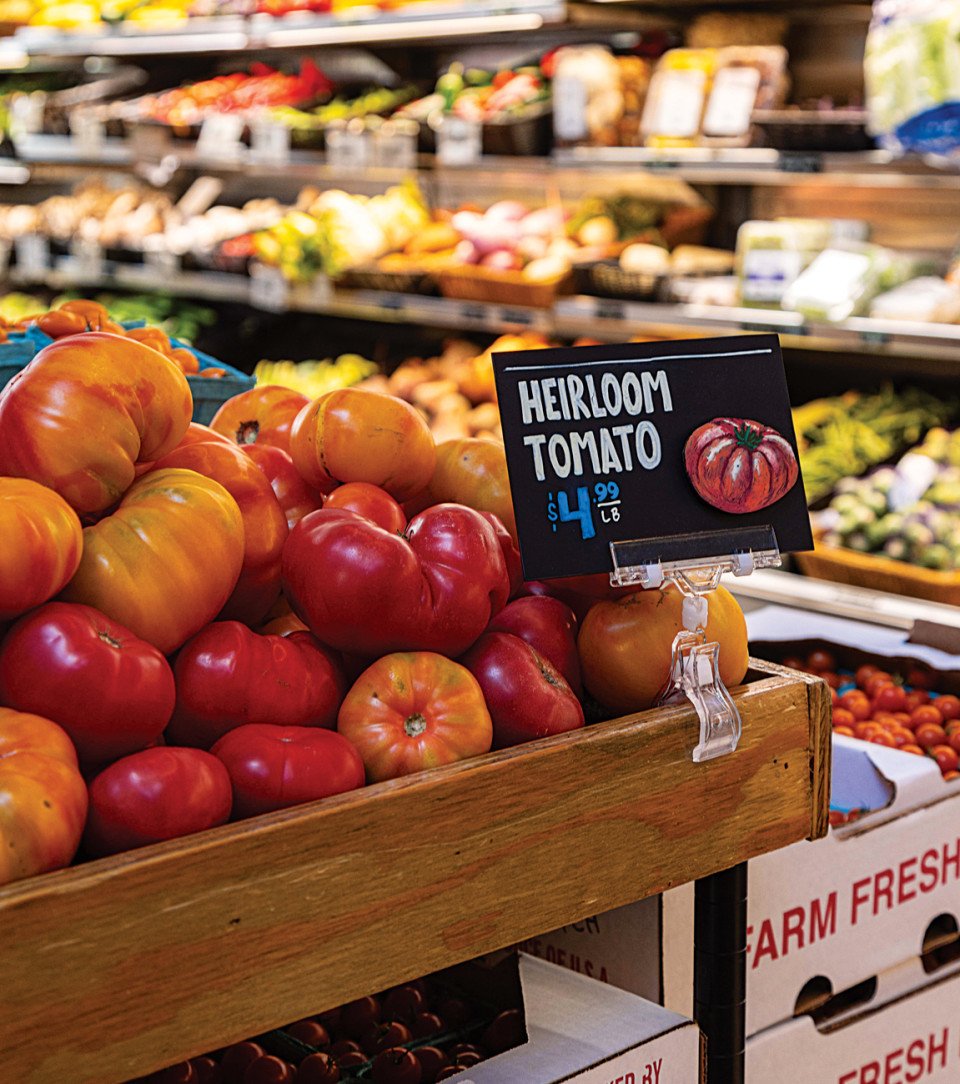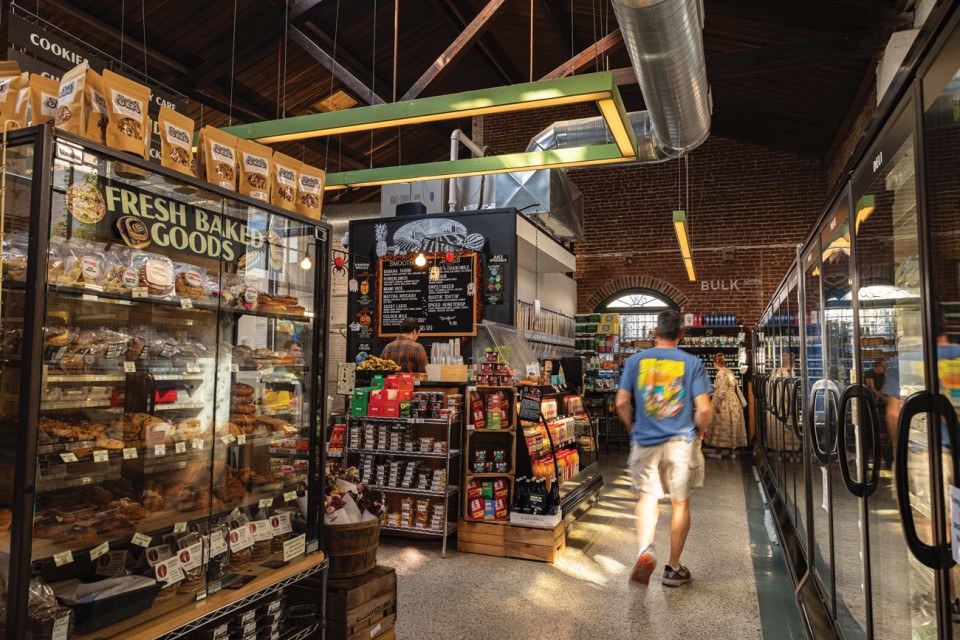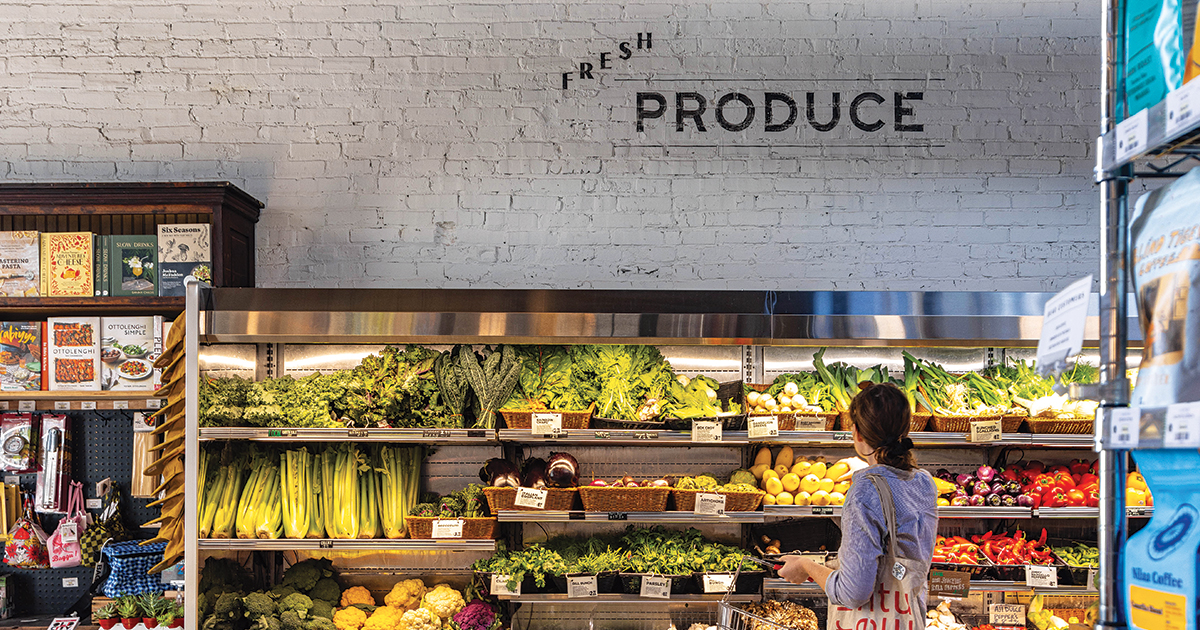Grocery shopping: We all do it — some with lists, some at multiple stores, some at the same time on the same day every week. Here’s how area residents are hitting the supermarket these days, and the factors driving our habits.
Shopping for produce at Riverwards in Old City / Photography by Gab Bonghi
I once lived above a grocery store, just outside of D.C. It was the life. My condo neighbors and I called it our extended pantry. Pop downstairs for a sushi snack, a bottle of wine on the way to a party, a whole chicken and whatever’s in season to roast after work. How European.
Those days are long gone. Since I moved home to Philly in 2015, grocery shopping has become a lot less off-the-cuff and efficient, and is now just another item on my endless to-do list. I’ve tried farm shares, a biweekly protein subscription, and lugging home bags of groceries so heavy they left reddish-purple lines on my shoulders. Now, in the suburbs, I do what many working parents do: bounce among a few stores, depending on the health of my bank account and my list.
“Somehow, I often end up having to go to six different stores — Wegmans, Whole Foods, Trader Joe’s, Assi, Weavers Way, Target — at various points during the week in order to get everything my family needs, which drives me nuts,” says Una Kang, who lives in Lower Gwynedd.
“The era of one-stop grocery shopping is over,” writes Rachel Wolfe in a Wall Street Journal article published earlier this year. “Now, with groceries taking up the highest percentage of household budgets in 30 years, more shoppers are driving all over town in pursuit of deals,” adds Wolfe, likening the activity to treasure hunting. (Sticker shock: Grocery prices are up 21 percent in three years!)
To mitigate the exhausting wild-goose chase, many shoppers, myself included, have tried buying groceries online, but it’s not the same. The frustration is real when it comes to apps’ limitations and the inevitable quality issues when the delivery arrives (or doesn’t). Ross Steinman, a professor of consumer psychology at Widener University, says the majority of people still prefer to shop in-store because it’s a sensory experience. “You can smell the freshly baked bread, you can see the vibrant display of fruits and vegetables, you can experience the tactile nature of different products.” Yeah, and you can make sure your produce isn’t moldy before checking out.
For others, going to the market is a welcome part of daily life. Tina Breslow, who lives in Fairmount, says food shopping is one of the highlights of her week. “I’m retired and love to cook and eat. I shop at different farmers markets usually on the weekends, Whole Foods or Rittenhouse Market during the week, and Maxx’s Produce almost daily.”
Even some parents of young children consider the task a fun activity. “We all love grocery shopping and go as a family,” says Jessica Eisenberg of Glenside, mom of two little kids. She goes to George’s Market at Dreshertown because it’s family-owned and doesn’t have a lot of middle aisles, “so there isn’t a lot of opportunity for the kids to see 927,492 brands of packaged junk.”
Steinman offers one tip we can probably all agree on: Don’t go to the supermarket hungry.
So when do we go? Sunday is the busiest day at GIANT, according to Tim Santoro, a vice president at the GIANT Company who is responsible for more than 90 Philadelphia-area stores. Riverwards Produce Market in Fishtown gets a dinner rush from 4 to 7 most evenings, especially Sundays and Mondays, says produce manager Judith Rosenberg. She says the small but thoughtfully stocked store typically also gets busy in the morning with “folks buying eggs, berries, fruit, and coffee.”

Grocery shopping at Riverwards
When it comes to where we shop, says Barbara Kahn, a marketing professor at Penn’s Wharton School, it’s about “location, location, location.” You want convenience, possibly easy parking. Otherwise, she says, it’s about what’s important to you, like discounts, gourmet goods, fresh fish, or great produce.
My mom in Northeast Philly, for example, is a bargain shopper. She hits up Aldi for the low prices and goes to ShopRite every Tuesday — list in hand — for the senior discount. My sister, on the other hand, needs proximity. A Fairmount resident and Whole Foods shopper, she can pick up only a handful of groceries per trip because she bikes.
While my sister jokes that anyone who thinks grocery shopping is a form of self-care “needs to get a massage,” Rosenberg at Riverwards begs to differ, saying that feeding yourself is self-care. She also considers supporting local farmers and producers — the ethos at Riverwards — community care. Prices are higher, but her customers generally accept it.
Elsewhere in Philly, budgets are tighter. Our region saw some of the highest grocery inflation in the nation last year, according to a ConsumerAffairs analysis. Steinman believes price is one of the top deciding factors for most grocery shoppers.
But Philadelphia also has a major food access issue. Lower-income neighborhoods often suffer from an oversupply of food high in sugar, salt, and unhealthy fats or lack markets at all. It’s part of the reason why more than 15 percent of Philadelphians experience food insecurity, according to the latest data from Feeding America.
Donta Rose, who owns a Grocery Outlet store in North Philly, may have the solution. His store, a fast-growing West Coast discount franchise, sells overstocks and closeout items that can be as much as 70-percent off normal prices.
The store is located across the street from a Philadelphia Housing Authority development, and many of Rose’s customers walk to do their shopping. “A lot of people treat it almost as if it’s a corner store,” he says, but with an important difference: Produce sales at Grocery Outlet have defied expectations. “In a neighborhood where people are used to going to corner stores for chips and sandwiches, once [fresh fruit and vegetables] are available, that’s what people will buy.”
Rose’s store serves a diverse mix of people from gentrifying Brewerytown, Temple’s campus, and the surrounding neighborhood (plus PHA workers on lunch break), which makes shopping trends hard to pin down. It gets busy at the beginning of the month when public assistance recipients get access to their funds, but also on Saturday nights when people are out and about, on Sunday afternoons, and after school and work during the week.

Baked goods, produce, and other groceries at Riverwards in Old City
Wherever or whenever you shop, we all have to get groceries. Maybe it doesn’t have to be such a chore, though, or so rigid. Rosenberg at Riverwards says they get plenty of organized shoppers with lists, like me, but “some people just stare into space and shop around” based on what excites them.
Maybe that next trip to the market offers a chance to break out of your routine, find a stake in your neighborhood, or get a bit whimsical, like back in my D.C. days. Ditch your list and see what inspires.
Published as “Aisle Affinities” in the 2025 issue of Be Well Philly.

